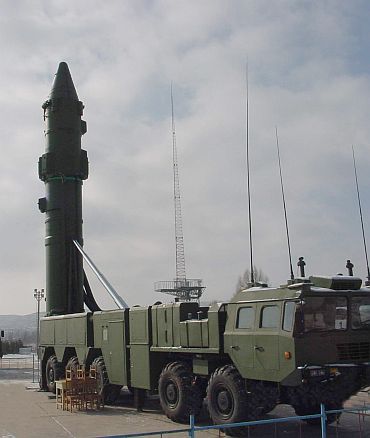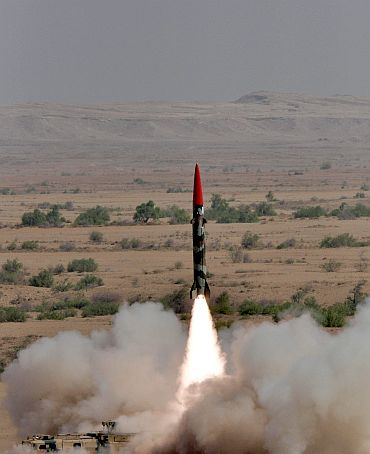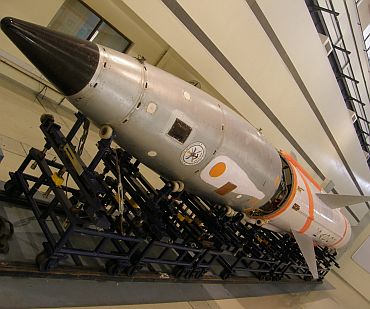
According to a new Pentagon report on China's military, Beijing has paid India a sort of compliment.
The People's Liberation Army now targets India with its best and latest nuclear-tipped missiles, the solid-fuel Dongfeng-21 (NATO designation: CSS-5) medium range ballistic missile (IRBM), tipped with a 250-kiloton nuclear warhead that would flatten a large part of Delhi.
Until now, India had been considered deserving only of China's oldest and most decrepit missile, the primitive, liquid-fuelled Dongfeng-3 (NATO designation CSS-2).
India's defence establishment is taking this new threat seriously, as also that posed by Pakistan's nuclear-tipped MRBMs -- like the Ghauri-2 and the Shaheen-2 -- which can strike targets 2300 kilometres away.
...

In an exclusive interview with Business Standard, the Defence Research and Development Organisation's chief missile scientist has announced that within three years, India will have a fully deployed missile-defence shield to safeguard a city like New Delhi from missile-borne nuclear attack.
Termed an anti-ballistic missile shield, this complex system has been in the making since 1996.
The DRDO is satisfied with the system's ability to detect and track an incoming missile, and then launch an interceptor missile to destroy it while it is still in space (exo-atmospheric interception).
If that misses, there is a second interceptor that homes in on the enemy missile while it is in the upper atmosphere (endo-atmospheric interception). In internationally watched tests, these interceptors have been tested thrice each.
But only now has the DRDO announced that a fully integrated ABM system is close to deployment.

Says Dr Avinash Chander, the DRDO's Chief Controller for Missiles and Strategic Systems; "We can deploy an effective ABM system for a single city within 3 years from now. We can definitely ensure the safety of one city in that time frame. After that, the [ABM shield for] other cities will follow."
Chander will not confirm that Delhi will receive India's first ABM shield, but given Delhi's vulnerability to MRBMs from Pakistan and China, and its status as the capital city, experts predict that it will almost certainly be the first city to be safeguarded.
"We are planning more ABM trials in a month or two. Both exo and endo-atmospheric interceptors are doing well in development. We already have a demonstrated capability against enemy missiles that are fired from up to 2000 kilometres away. After some more trials we will be going into deployment mode. The ground systems and the missiles are going to be available there is no issue," says Chander.
The sophistication of an ABM system depends upon the range of the incoming enemy missile. The longer the range of the incoming missile, the faster it travels and the more difficult it is to it detect and shoot it down. The missiles that currently target India -- the Shaheen; the Ghauri; and the Dongfeng-21-- can all be successfully intercepted, says the DRDO.

"Pakistan can only target India with missiles that have ranges of less than 3000 kilometers, otherwise the missile will overshoot India. Our ABM system will be capable of detecting and shooting down incoming missiles from those ranges," says Chander.
However China, with its arsenal of longer-range intercontinental ballistic missiles (ICBMs), and the geographical space to launch missiles from thousands of kilometres away, is capable of defeating India's ABM system in its current form.
The DRDO says that it will gradually enhance the ABM system to enable the interception of longer-range missiles. For now, deployment is on track, says the DRDO's missile chief.
The radar network that is needed to detect an incoming enemy missile is already being sited. This includes a Long Range Tracking Radar, which Bangalore-based Electronics and Radar Development Establishment has developed in collaboration with Israeli company, ELTA.

The LRTR picks up incoming missiles at ranges out to 300 kilometres.
The ABM system also has a 'guidance radar', which tracks the incoming missile in its terminal phase and guides the interceptor missile onto the target.
The DRDO developed the guidance radar in collaboration with French company, Thales. In addition, ABM systems also use satellite-based detection systems to detect enemy missile launches.
The ABM systems are controversial; strategists argue that they destabilise a nuclear balance, incentivising the production of more nuclear weapons to defeat an enemy's ABM shield.
Indeed, Pakistan now has the world's fastest growing nuclear arsenal after it aggressively expanded its Khushab reactor complex to produce more plutonium for bombs.